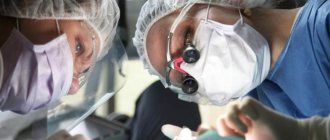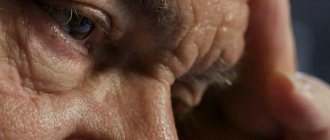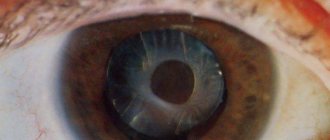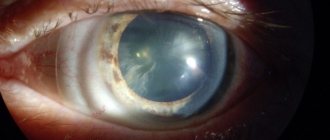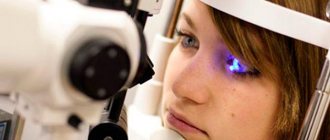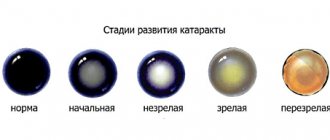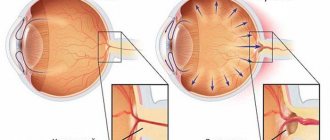Causes of cataracts in old age
Cataracts are characterized by partial or complete clouding of the lens of the eye, resulting in loss of the ability to see clearly. The lens, which has lost its transparency, does not transmit light, the clouded area expands over time, and vision rapidly deteriorates.
Cataracts are diagnosed not only in old age. The disease can be congenital, traumatic, radiation or complicated, and can also be a consequence of various pathologies. However, according to statistics, this disease most often affects people over 60 years of age.
The following factors contribute to the development of cataracts:
- Glaucoma, myopia 3 degrees.
- Diabetes mellitus, metabolic disorder.
- Genetic predisposition.
- Eye injuries: mechanical, chemical, concussion.
- Radiation, ultraviolet and radiation exposure.
- Long-term use of certain groups of medications.
- Severe intoxication, poisoning with mercury, thallium, etc.
- Unfavorable ecology in the region of permanent residence.
Also, recent studies by scientists from around the world prove the negative effects of nicotine on vision and confirm the theory that one of the reasons for the development of cataracts is active smoking.
Cataract stages
The process of clouding of the lens of the eye is gradual, so it can take 7–10 years from its onset to the diagnosis of cataract. However, there are many cases where this process is quite rapid and leads to blindness in just a few years.
Pathology has four stages of development:
- Initial. As a rule, making a diagnosis at this stage is difficult due to the absence of any pronounced symptoms. Only an ophthalmologist can determine the initial degree of cataract after diagnosing the fundus.
- Immature. This stage of cataract development is characterized by deterioration of vision and severe clouding of the lens of the eye.
- Mature. At this stage, the lens becomes completely cloudy, does not transmit light, and the person loses the ability to distinguish the contours of objects.
- Overripe. This is the last stage of cataract, which is characterized by the disintegration of the lens, resulting in complete loss of vision.
Only a specialist can determine the stage of development of this pathology after carrying out certain diagnostic measures.
How is the disease diagnosed?
The problem with cataracts is that at the initial stage of its development the patient practically does not notice any pathological disorders. The process of thickening and clouding of the lens can be gradual, so that the patient may feel that his vision is simply sagging slightly, which is directly related to old age.
Constantly postponing the treatment of the disease will lead to the fact that surgery will become the only way to prevent complete blindness.
Only an ophthalmologist can detect the disease at an early stage. However, if the clouding of the lens has already moved to the central optical zone, then the patient himself may suspect something is wrong, since it will constantly seem to him that the surrounding reality is covered in thick fog. Such a “veil” before your eyes will constantly interfere with even the simplest daily tasks. This stage of the disease even has its own name - immature cataract. This pathology can be quickly dealt with if treatment is started immediately.
But when the cataract reaches the stage of full maturity, the lens becomes completely cloudy. A person will be able to distinguish only the outlines of objects and will not see anything even at arm's length. In this case, surgery will come to the rescue.
But at the stage of overripe cataracts, the lens will become milky white. The patient will become almost completely blind and will not even be able to determine whether there is a source of any light nearby. Here it is definitely not possible to cope with the disease without surgery. The absence of surgical intervention can lead to serious consequences, for example the development of secondary glaucoma, complicated by iridocyclitis (which threatens not only complete blindness, but also loss of the eye as a whole).
To diagnose cataracts, an ophthalmologist will use a special slit lamp to determine the intensity of blood supply inside the eye vessels. The doctor will also examine the retina and determine the stage of the disease. In some cases, visometry will be used - a special way of assessing visual acuity.
Symptoms of cataracts
In most cases, a person notices deterioration in vision only after a significant part of the lens of the eye is damaged. However, there are signs indicating earlier development of cataracts, these include:
- Sensation of a “veil” in the eyes.
- Rapid deterioration of visual acuity.
- Double vision in one eye while the other eye is closed.
- Increased eye sensitivity to light.
- Deterioration of night vision.
- Violation of color perception.
- The appearance of glare.
Cataracts are not accompanied by external signs of vision changes, and the presence of these symptoms helps to accurately make a diagnosis.
Diagnostics
To make a diagnosis of cataract, an ophthalmologist prescribes a number of modern diagnostic methods:
- Biomicroscopy: ultrasound examination of the eye.
- Slit lamp examination: examination of the cornea and iris of the eye to determine clouding of the lens.
- Visometry: determination of visual acuity using a special table.
Classic diagnostics of the organ of vision reveals only the presence of the disease, but does not determine the cause of its occurrence. If the lens darkens and the eyes hurt in bright light, then an additional laboratory examination is prescribed.
How is it useful for cataracts?
The product has a positive effect on the vision system, in particular, it can be used to remove the veil from before the eyes. If you regularly treat your eyes with a natural beekeeping product for 1-2 months, you can achieve the following positive effects:
- improvement of visual acuity;
- stabilization of intraocular pressure;
- disappearance of the veil before the eyes;
- improving blood and lymph flow;
- maintaining the tone of the periocular muscles;
- normalization of eye nutrition;
- disappearance of image ghosting;
- slowing down degenerative processes in the lens.
Surgical treatment of cataracts
There are two methods used to treat cataracts: medication and surgery. Medication includes special medications, but it is important to remember that they are not able to stop the clouding of the lens, and their action is aimed only at stopping the pathological process.
The only way to cure cataracts is surgery. It has gained recognition due to its effectiveness, safety and minimal risk of complications. The duration of phacoemulsification (cataract surgery) depends on the degree of pathology and ranges from 15 minutes to half an hour.
Before surgery is scheduled, a complete examination of the patient is carried out, the type of cataract is assessed, and possible contraindications are identified. Phacoemulsification is contraindicated in the presence of the following pathologies:
- Diabetes.
- Blood clotting disorder.
- Retinal disinsertion.
- Glaucoma (in a form not amenable to laser correction).
- Malignant neoplasms.
- Eye diseases (infectious and inflammatory).
Even in the absence of any contraindications, the patient requires consultation with a general practitioner who will prescribe a series of laboratory tests.
Half an hour before the operation, the ophthalmologist measures systemic and intraocular pressure and instills special drops that dilate the pupils. Surgery is performed under local anesthesia using anesthetics.
Collections of medicinal herbs
Honey for the eyes can be used not only to treat these organs and relieve fatigue, but also to normalize eye pressure. If it is elevated, then you can prepare the following solution: you need to take six parts of distilled water and three parts of linden honey.
By mixing both components, you will get a sweet healing liquid that needs to be dripped into each eye once in the amount of one drop. The duration of such treatment should be about 10 days.
This procedure is best done before bedtime.
After the first stage of treatment, it is advisable to increase the concentration of the solution. Thus, you need to take four parts water and one part honey.
Using this remedy, therapy should be continued for 10 days. In the future, it is recommended to make the solution in proportions 1:1, 1:2 and 1:3.
In the final 10 days, honey for the eyes should be used in its pure form, one drop at a time. If the sweet product has thickened, it should be melted in a water bath and then cooled to room temperature.
This method has been known for quite a long time. It quite effectively and quickly normalizes eye pressure.
If you are constantly tormented by inflamed eyelids, then you can use honey for the skin around the eyes. To do this, you need to take 200 ml of distilled water, several geranium flowers, a dessert spoon of honey, and then put them in one bowl, shake and leave for a day at room temperature. After time, the solution must be filtered and washed with it on the inflamed eyelids before bed for a week.
In folk medicine, there are many recipes for the treatment of cataracts. They are based on collections of medicinal herbs.
Recipe 1
Collection based on horsetail grass is quite common. To prepare it, take 30 grams of dried and crushed grass. Strengthening the therapeutic effect is achieved by including stinging nettle (10 grams), knotweed herb (15-20 grams are enough). Horsetail should be dried and finely chopped, and nettles should be taken fresh and young.
Preparation: mix all ingredients and take 10 grams of the resulting mixture. Pour boiling water (1 cup), reduce heat to low and cook for 3 minutes. Then the mixture must be cooled and strained.
Application: the infusion is consumed before meals, 100 ml at a time. The course is 14-21 days.
Complications
In 99% of cases, cataract surgery takes place without any complications. However, if the patient does not follow the doctor’s recommendations, complications such as:
- Increased intraocular pressure.
- Retinal disinsertion.
- Inflammation of the optic nerve.
- Hemorrhage into the vitreous body.
- Corneal dystrophy.
If pain and spots appear before your eyes, you should immediately consult an ophthalmologist.
Non-surgical cataract treatment
If an elderly person has cataracts, can surgery be avoided? This question worries those whose loved ones are faced with the disease. In most cases, treatment of early stage cataracts involves only drug therapy. This continues until the pathology worsens and the condition of the organ of vision deteriorates rapidly. However, it is important to remember that treating cataracts with medications is only a temporary measure and its effect is short-lived.
As a rule, conservative methods over a long period are indicated only in cases where there are contraindications to surgery. Drug treatment includes the use of various eye drops that slow the progression of the disease.
All medications must be taken constantly; the attending physician prescribes a treatment regimen and regularly monitors the development of cataracts. Uncontrolled use or independent withdrawal of the drug is unacceptable, since this can only aggravate the development of the pathology.
The following drugs are used for drug therapy:
- "Vita-iodurol." An effective drug prescribed for the complex treatment of eye diseases, it contains nicotinic acid, calcium chloride, adenosine and magnesium chloride, which are necessary to strengthen the cornea of the eyes.
- "Taurine." Amino acid preparation with high sulfur content. It has a powerful stimulating effect on degenerative processes that occur in the lens of the eye.
- "Quinax." A drug that suppresses the synthesis of oxidative compounds that destroy the lens proteins of the eyes.
- "Vitafacol". Eye drops that improve the oxidative processes occurring in the organ of vision.
- "Pyrenoxine." A drug that normalizes glucose metabolism and its penetration into the capsule of the eye lens.
- Vitamins B2, riboflavin. Administered intramuscularly for vitamin deficiency in the body.
In addition, drug treatment includes the use of physiotherapeutic methods: electrophoresis with a solution of the amino acid cysteine.
Also, treatment of cataracts in old age using a conservative method involves treating pathologies that contribute to its occurrence. Such diseases include hypoparathyroidism, diabetes mellitus, etc.
Methods of application
Treatment of cataracts with honey should be daily. It is recommended to combine several therapy methods using a natural product. The most effective recipes include the following:
Homemade honey eye drops are an effective way to treat cataracts.
- Eye drops. Honey is diluted in mineral water without gas in a ratio of 1:4. The product must be dripped into the eyeballs 4-5 times a day. Dosage - 1 drop. On day 6 the concentration increases. The course of treatment is 1 month. In recent days, the proportion becomes equal if discomfort and burning does not occur.
- Putting in the eyes. It is necessary to place 1 g of the sweet mixture on the eyeball, pulling the lower eyelid. Mild itching and increased tear production are a normal reaction of the body, as the nutrition of the organ is normalized. However, if the symptom does not go away for more than 1-2 hours, you should rinse your eyes with cooled boiled water.
- Drops with added aloe. Spring water, liquid linden or acacia honey and fresh aloe juice are diluted in equal concentrations. Instillation is recommended - 1 drop 3 times a day.
- Treatment of eye cataracts with honey and eggs. The product is boiled for 5 minutes, then carefully cleaned so as not to damage the protein. The yolk is removed with a spoon. Liquid honey is poured into the hole, after which the egg is left for 1 day. The liquid is drained and dropped into the eyes 2 times a day, 2 drops. Alternatively, to speed up the preparation of the product, place a boiled egg with honey in the oven for 30 minutes.
- Recipe with apple. The top of the fruit is cut off, then the middle is picked out. Bee nectar is poured inside, and the apple is closed with an improvised lid. After 2 hours, it is necessary to pour the resulting liquid into a glass container. Instillation of 2 drops is indicated. 3 times a day. The duration of the treatment course is 3-4 months.
Prevention
It is necessary to take care of the condition of the organ of vision at any age, then there is a high probability that it will be possible to avoid the development of cataracts. Preventive measures that can preserve good vision for many years:
- Proper nutrition. Include at least 500 g of fresh vegetables and fruits in your daily diet.
- Protect your eyes from sun rays. Wearing sunglasses with the acronym ANSI will protect your eyes from both ultraviolet radiation and sunlight.
- Compliance with watching TV and working at the computer. Take a break for at least half an hour after every 1.5–2 hours of using this technique.
- Avoid eye injuries (mechanical, chemical, concussion).
- Cholesterol control (in old age, the development of cataracts may occur due to its increased content).
- Visit an ophthalmologist after 45 years of age at least once a year.
The main reason for the development of cataracts in old age is age-related changes in the lens of the eye. Following these recommendations will help reduce the risk of its occurrence, and timely diagnosis will help avoid surgical intervention.

